Lance Weiler: The Fact About The Last Broadcast

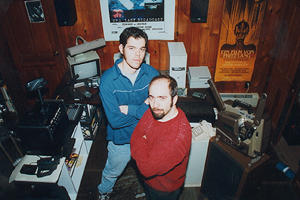 While all eyes were directed towards this year’s indie surprise hit, “The Blair Witch Project” two young filmmakers were looking at each other in amazement, trying to fathom what had just happened to them. Hadn’t they created a film two years earlier the showed a frightening resemblance to this new highly touted indie wonder? The two filmmakers in question are Stefan Avalos and Lance Weiler, and the film they first showed to audiences in the fall of 1997 was called “The Last Broadcast”. The movie is now available on VHS and DVD through Ventura Distribution, and it finally gives audiences the chance to see how close the similarities between these films are, and how much of the predecessor really made it into Haxan’s overnight hit that swept through movie theaters this summer.
While all eyes were directed towards this year’s indie surprise hit, “The Blair Witch Project” two young filmmakers were looking at each other in amazement, trying to fathom what had just happened to them. Hadn’t they created a film two years earlier the showed a frightening resemblance to this new highly touted indie wonder? The two filmmakers in question are Stefan Avalos and Lance Weiler, and the film they first showed to audiences in the fall of 1997 was called “The Last Broadcast”. The movie is now available on VHS and DVD through Ventura Distribution, and it finally gives audiences the chance to see how close the similarities between these films are, and how much of the predecessor really made it into Haxan’s overnight hit that swept through movie theaters this summer.
Interestingly enough, “The Blair Witch Project” did not only lend the basic story idea and the general approach from “The Last Broadcast”, but also used exactly the same marketing techniques and tricks to increase the publicity for their picture.
In 1998 Avalos and Weiler visited the Sundance Film Festival with “The Last Broadcast” in their backpack. The movie had been under serious consideration for a midnight viewing at the Festival but was suddenly pulled for a number of reasons.
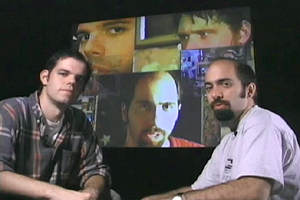 Exactly one year later, “The Blair Witch Project” was screened in exactly the same midnight spot, which eventually lead to Haxan’s distribution deal with Artisan Entertainment and gave the film the financial backing and publicity that ultimately made it the success it is.
Exactly one year later, “The Blair Witch Project” was screened in exactly the same midnight spot, which eventually lead to Haxan’s distribution deal with Artisan Entertainment and gave the film the financial backing and publicity that ultimately made it the success it is.
The year before, Weiler and Avalos had been handing out advertisement flyers during the Festival, featuring the missing filmmakers from their movie, which added to the mystique of the pseudo-documentary. The two also created an elaborate website with fictional information and faux interviews, as well as a full timeline and details of the imaginary events that build the foundation of “The Last Broadcast”. All of these strategies should be duplicated almost identically one year later when the cogs of publicity started their grindwork for “The Blair Witch Project”.
Everything seems to be identical between these films and one can’t help but feel warped in a time-space-continuum when following the details, but the major difference is that “The Last Broadcast” was finished a full two years before “The Blair Witch Project” unleashed its attack on the box office. For the young filmmakers who created “The Last Broadcast” this must have been an almost traumatic experience one would think, but Lance Weiler, is surprisingly rational in his take.
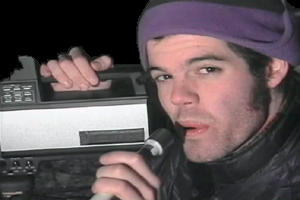 “Of course, it took us back when we heard about it,” Lance Weiler tells me. “Upon reading the synopsis the two films sound strikingly similar to the point that journalists came back to us, congratulating us on the acquisition at Sundance. We had to tell them, “It’ not our film”, but that’s how similar the perception was, and indeed, apart from the story, there are some striking conceptual similarities.”
“Of course, it took us back when we heard about it,” Lance Weiler tells me. “Upon reading the synopsis the two films sound strikingly similar to the point that journalists came back to us, congratulating us on the acquisition at Sundance. We had to tell them, “It’ not our film”, but that’s how similar the perception was, and indeed, apart from the story, there are some striking conceptual similarities.”
But nonetheless, Weiler is thankful for the success of “The Blair Witch Project” – as paradox as it may seem. “It was the best thing that could have happened happen to our movie at this point. It took the cult status away from these films and created a firestorm. We receive tons of email from the UK where “The Blair Witch Project” recently opened, with questions about our film. It’s a nice compliment because you want people to see your film and here we get the recognition. Of course, we never thought it would resolve from something like that,” he adds sarcastically. As surprising as this attitude may seem, Weiler shows a maturity in his attitude that is truly astonishing. He recognizes the fact that apart from “The Last Broadcast” having been the smash hit, riding the tidal wave out as the predecessor to the controversial smash hit, is the next best thing that could have happened to them. He also sees striking differences between the two films however. “In a way, our movie deals with reality and the way media present this reality. It is almost ironic that we’re pushed in the media spotlight and that we became the cover story on “Extra”, “E!”, “Good Morning America”, the “Howard Stern Show” and so on,” he contemplates.
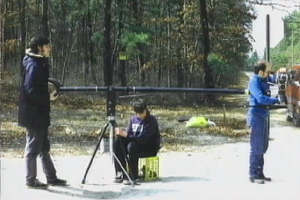 Although it was a sticky situation for the young filmmakers to be faced with a film that freely borrowed from their ideas, they decided not to get caught up in legal issues. “In the end what we decided to do was to take the high road and let people decided what to think for themselves. Not get entangled in legal issues and do films instead. It was a hard decision, but at the same time it simply gives you more piece of mind. Stefan and myself against Artisan, that somehow doesn’t seem right.”
Although it was a sticky situation for the young filmmakers to be faced with a film that freely borrowed from their ideas, they decided not to get caught up in legal issues. “In the end what we decided to do was to take the high road and let people decided what to think for themselves. Not get entangled in legal issues and do films instead. It was a hard decision, but at the same time it simply gives you more piece of mind. Stefan and myself against Artisan, that somehow doesn’t seem right.”
But even without the existence of “The Blair Witch Project” in the equation, what Avalos and Weiler did was a phenomenal success, not only pecuniary, but also ethically and in an inspiring way. They took the film they had shot themselves on home video equipment with a budget of $900 dollars around the world, creating their own digital distribution system that would gradually expand. The most notable side effect was the signal it send to aspiring filmmakers in the rest of the world that it doesn’t take millions of dollars to create captivating films, and the two told everyone they met on their way, that they too can make films themselves.
 Nonetheless, the shadow of the Blair Witch is omnipresent, not only for unsuspecting audiences, but for the filmmakers as well, and during the last visit to the Cannes Film Festival they met the creators of the film. “Eduardo Sánchez and Daniel Myrick were on the same flight with us,” Weiler remembers with a laugh of disbelief. “We couldn’t believe they were sitting right in front of us. We were talking about the films a little, but that was about it. Later in Cannes then all sorts of people approached us because they wanted to write stories about both movies. We decided to put it all off, because that’s not how we wanted to be known. The films are similar, but they are also different, and we weren’t interested in getting involved in creating that kind of picture. It got to the point that we had the impression people ran out of material to write about Blair Witch and started to turn to us for some dirty laundry.”
Nonetheless, the shadow of the Blair Witch is omnipresent, not only for unsuspecting audiences, but for the filmmakers as well, and during the last visit to the Cannes Film Festival they met the creators of the film. “Eduardo Sánchez and Daniel Myrick were on the same flight with us,” Weiler remembers with a laugh of disbelief. “We couldn’t believe they were sitting right in front of us. We were talking about the films a little, but that was about it. Later in Cannes then all sorts of people approached us because they wanted to write stories about both movies. We decided to put it all off, because that’s not how we wanted to be known. The films are similar, but they are also different, and we weren’t interested in getting involved in creating that kind of picture. It got to the point that we had the impression people ran out of material to write about Blair Witch and started to turn to us for some dirty laundry.”
“I think in a lot of ways they are very different pictures. Ours is viewable more than one time. There are clues throughout the movie about what’s going on and you can study these clues when you re-view the film. It’s like a psychological thriller, whereas Blair Witch is first person and supernatural. They go from point A to point B, while ours jumps off. The biggest compliment we received about the film was from “People Magazine”, who said what Coppola’s “The Conversation” was to Watergate, is what “The Last Broadcast” is to Monikagate,” he laughs.
Another movie looms in many people’s minds when it comes to both, “Blair Witch” and “The Last Broadcast”. The 1979 Italian splatter movie “Cannibal Holocaust” used the idea of a news team that discovered a camera and lost footage of a crew that went into the amazon to film cannibals is by many seen the father of both films. “I wish I had seen it,” Weiler comments enthusiastically. “I have heard a lot about it, but in regards to the story and all that it seems to be more in the line of the Fulci school of splatter movies. We have had a lot of people say, you stole that from “Cannibal Holocaust”, and “Cannibal Holocaust” is the original. I’ve heard it might get a re-release, and I’ll definitely check it out. Now, unless I pick it up from some obscure source, there’s no chance for me to see it, and believe me, I would like to see it. I would like to see if our film is indeed similar, and if, where is it similar.”
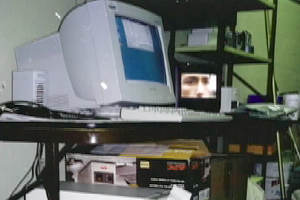 “As far as mocked documentaries, “David Holzman’s Diary” from 1968 was one of the influences. If there was any film we really liked, it was this movie about a guy who is going to Vietnam. He documents what is going on and all the time you watch him as things happen. In the end when the film is over, it rolls with these credits and you’re completely taken aback in surprise that it was not real. If any movie was an influence for us, it was films like this and maybe “Blow Up” by Michelangelo Antonioni. “The Last Broadcast” also contains many elements from other films however, even Polanski’s “The Tenant”, or the psychological element of “Rosemary’s Baby” is there. ?The idea of a group of individuals in the wild who want to find the truth, feeling it’s their mission to find out what happened to these people is a really compelling story. It has elements of “Hardcopy” or “Dateline”.”
“As far as mocked documentaries, “David Holzman’s Diary” from 1968 was one of the influences. If there was any film we really liked, it was this movie about a guy who is going to Vietnam. He documents what is going on and all the time you watch him as things happen. In the end when the film is over, it rolls with these credits and you’re completely taken aback in surprise that it was not real. If any movie was an influence for us, it was films like this and maybe “Blow Up” by Michelangelo Antonioni. “The Last Broadcast” also contains many elements from other films however, even Polanski’s “The Tenant”, or the psychological element of “Rosemary’s Baby” is there. ?The idea of a group of individuals in the wild who want to find the truth, feeling it’s their mission to find out what happened to these people is a really compelling story. It has elements of “Hardcopy” or “Dateline”.”
“When it came to the film’s distribution we found ourselves in a dilemma because of economic constraints,” Weiler remembers some of the stepping stones. “We wanted to push the envelope, so much was clear but we could never go to celluloid with our film. Creating a 35mm print runs into the tens of thousands of dollars – money we did not have. We had initial distribution offers form people but we did not want to go with these traditional routes. Stefan had released another picture before and he had some negative experience with other people. The good thing was that because “The Last Broadcast” had such a low budget, there was no need for recoupment. So we decided to push it our own way, creating new territory. We brought our own digital projectors to film festivals around the world to show the movie. Now they have them there, but back then, we carried them.”
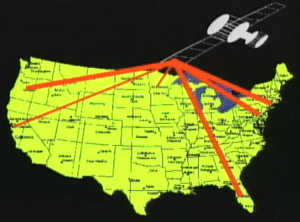 “The next step was to set up a digital distribution system via satellite. Hollywood came knocking when everything blew up with “Blair Witch”, but since nothing in our system was broken, we did not want to fix anything,” Weiler mentions sardonically. “We wanted to retain the rights to our film and in the long run we made about six to seven times what they had offered us. We are nowhere near “Blair Witch” but we made good money and have offers and opportunities to do other things. That by itself is more than you can ask for, and the knowledge of having created a cult film.”
“The next step was to set up a digital distribution system via satellite. Hollywood came knocking when everything blew up with “Blair Witch”, but since nothing in our system was broken, we did not want to fix anything,” Weiler mentions sardonically. “We wanted to retain the rights to our film and in the long run we made about six to seven times what they had offered us. We are nowhere near “Blair Witch” but we made good money and have offers and opportunities to do other things. That by itself is more than you can ask for, and the knowledge of having created a cult film.”
Now, “The Last Broadcast” has been released on DVD, an outlook that gets the young filmmakers excited. “It’s so excellent that it’s finally coming on DVD, the movie we started in 1996,” Weiler says. “When we started the project all films were shot on celluloid, which is very expensive. Our idea came out of the frustration of waiting to shoot on film. Eventually we had this idea to create a digital movie so it can actually be distributed in digital form as well.”
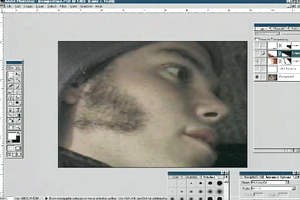
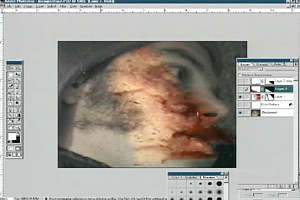
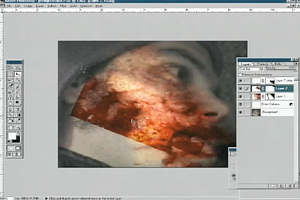
Stefan Avalos and Lance Weiler put quite a bit of effort in the release of this DVD themselves and were fully involved in the development. In order to match the film’s mood, the decided to do the menuing on the disc themselves. “It just makes sense, “ Weiler explains. “If you start digitally with 1s and 0s, why not stick within the domain all the way? Stefan actually did the DVD’s main menus.”
The two also recorded a commentary track for the DVD and created a number of featurettes specifically for the DVD. It covers behind-the-scenes material, the production of the movie, the post-production of the movie on their desktop computers, all the way to their digital satellite distribution system, as well as a documentary that uncovers the true legend of the Jersey Devil.
“I recently got a DVD player,” Weiler tells me excited. “And I love the bonus material that can be found on many of them. That was the reason why we went back and shot new material for our DVD. Warner’s release of “The Shining” was a break-through experience for me on DVD. I had never heard Stanley Kubrick talk before, and then seeing this fantastic documentary was very exciting. The future of the medium is something people have barely scratched and it’s incredible how it’s coming along. DVD is great. I always wanted to collect movies but VHS was just such a bad format, quality and deterioration-wise, while Laserdiscs were cumbersome and expensive. DVD is very much what I was looking for. It’s still rather small, especially if you want some obscure titles, but is growing so phenomenally.”
The disc’s authoring was done by Optical Disc Media, who guided Avalos and Weiler though the entire process of creating a DVD. “We talked to a number of different places, “Weiler remembers, “but they didn’t really understand what we wanted to do with the release. Optical Disc Media did a great job authoring and replicating the DVD for us.”
Currently Stefan Avalos is working on an action adventure while Lance Weiler is writing the script for a comedy. “The Last Broadcast” has opened many doors for the young filmmakers and the knowledge that they have the technology on their hands to do whatever they want to do gives them a lot freedom. Until they present their next film, try to catch “The Last Broadcast” on DVD and see for yourself how $900 can be turned into a memorable experience for thousands of viewers.

Leave a comment
You must be logged in to post a comment.